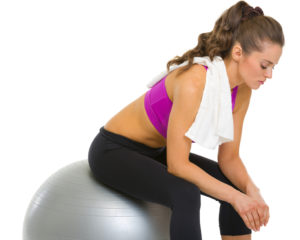Do You Suffer From Muscle Soreness After Exercise?
The ‘No Pain No Gain’ mantra has been around for decades and it relates to the muscle soreness after exercise that most people experience after a heavy workout session. However, did you know that this pain doesn’t have to be inevitable?
Contrary to popular belief, you don’t have to feel pain in order to know you’ve had an effective fitness session. Here are some of the best ways to prevent muscle soreness after exercise.
Free Report: The Best Type of Weights for Your Workout
Keeping The Body Hydrated
The best thing you can do to reduce the chances of developing muscle soreness after exercise is to ensure you stay hydrated. The cells of the muscles need water and when you exercise, you lose a lot of that water through sweating.
So unless you top up those water levels during and after your workout, dehydration will occur. This is largely what contributes towards exercise related muscle soreness.
Be Sure To Warm Up and Cool Down Properly
You’ve likely heard that warming up before a workout is extremely important. However, many people fail to adequately warm up the muscles before exposing them to strenuous exercise. Not only does this increase the risk of injury, but it will also leave you feeling very sore afterwards.
Stretching is a particularly great way of preventing soreness and has been proven to help in a German study back in 1995. In fact, the study even showed that not stretching before and after exercise can aggravate muscle soreness. The cool down is just as important as the warm up.
The Importance Of Nutrition
Did you know that what you eat has a massive impact on how you feel after exercise? Your body needs a good level of nutrition in order to recover properly. Certain types of foods can help with muscle repair and ideally you need to focus on what you’re eating at least a day before you exercise.
A general rule that will help is to consume 40% protein, 20% fats and 40% carbs the day before. On the actual exercise day you should also be eating a high protein, complex carbohydrate and good fat diet.
These are just three ways to prevent aching after exercise. Of course, it’s also important not to push your body past its limits. Trying to do too much too soon will aggravate the muscles and lead to a lot more pain than you should experience after working out.
The Best Weights To Avoid Muscle Soreness After Exercise
Some people shy away from using weights since they think it will make them get bigger rather than smaller. But using weights will help you to tone up and can actually help to burn more calories during resting times.
The best way to do weight training exercises is to use a variety of weights. To help you choose the right weights for your workout download my free report, How To Choose The Best Weights and avoid any muscle soreness after exercise.



Pingback: How To Make Cardio Less Boring - How To Get Flat Abs Fast
Pingback: Which is Better, Steady State Cardio or HIIT? - How To Get Flat Abs Fast
Pingback: How Do You Know How Much Weight To Lift? - How To Get Flat Abs Fast
Pingback: What's The Difference Between HIIT and Tabata Exercise? - How To Get Flat Abs Fast
Pingback: Foods That Help Your Brain Focus Better - How To Get Flat Abs Fast
Pingback: How To Regain Weight Loss Motivation - How To Get Flat Abs Fast
Pingback: How To Sweat Out Your Toxins - How To Get Flat Abs Fast
Pingback: Stress Kills: How To Take Control Of Your Stress
Pingback: What To Do When Your Body Hurts After Exercise
Pingback: What Is The Best Exercise For Losing Belly Fat? - How To Get Flat Abs Fast
Pingback: How To Lose Weight With Low Impact Exercise - How To Get Flat Abs Fast
Pingback: 10 Nutrients To Eat Post Workout To Speed Up Recovery
Pingback: Why Your Muscles Hurt After a Workout - How To Get Flat Abs Fast
Pingback: Simple Tools To Help You Measure Your Endurance
Pingback: How to Know When to Rest Rather than Working Out